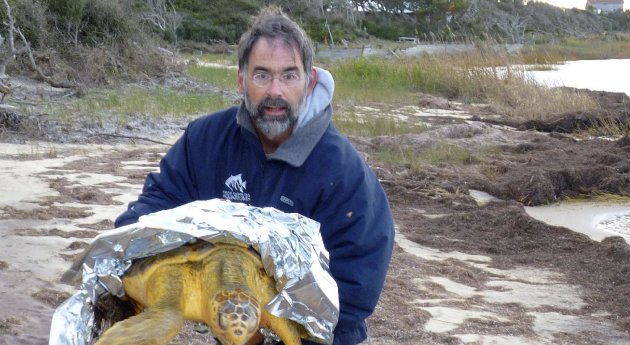
The sea turtles
— typically green, Kemp's Ridley and the occasional loggerhead — tend
to be juveniles who get so busy gorging themselves on the near-shore
goodies that they don't get around to moving out to the warmer Gulf
stream before a cold spell hits.
"This is really one of the absolute hot spots on the planet for cold stunning in almost any year," said Liz Browning Fox of Buxton on Hatteras Island,
who rescues cold-stunned turtles that beach themselves or get stuck
along the edge of the Pamlico Sound. "We have a huge sound system in
North Carolina, and it's like a feasting table for several species ...
Juvenile sea turtles feast on this delightful table. Like teenagers,
they stay at the table as long as you'll let them."
Because they're cold-blooded,
turtles' body temperatures match their environment. When the water
temperature drops below 50 degrees, they become too lethargic to move
into warmer water. Since the first cold-stunned turtle of the winter was
found, Dec. 23, 2012, along Cape Lookout, rescuers have taken in 72
live turtles and found six others dead, said Matthew Godfrey, the state
sea turtle biologist in Beaufort. The vast majority of the rescued
turtles survived, he said.
Some years, as many as 150 cold-stunned turtles have been found in North Carolina, he said.
Most of the turtles this year are
being found along Hatteras and Ocracoke islands, said Karen Clark,
program coordinator at the Outer Banks Center for Wildlife Education and
an adviser to the Network for Endangered Sea Turtles on the Outer Banks.
On Hatteras Island, one volunteer goes out each morning and checks
the water temperature. When it's below 50 degrees, a core group of about
10 volunteers is alerted to search for cold-stunned turtles.
Fox dons knee boots while others wear hip waders that allow them to go into deeper water. Fox's brother, Lou Browning,
brings turtles in on his kayak, sometimes cradling them on his lap. The
volunteers carry these heavy turtles long distances to get them to a
car. A 25-pound turtle weighs a lot after a half-mile walk through muck,
Fox said.
"When it comes to turtles, we bend over backward to do whatever we can whenever we can," Lou Browning said.Turtles "are just simply amazing creatures," he said. "They've been around so many millions of years. They're the toughest animals on earth. They survive things that no other creature can."
People who find turtles should call NEST, which has a hotline that operates 24 hours a day, seven days a week. And never assume a sea turtle is dead, Fox says. Passers-by ignored one upside-down turtle, assuming it was dead, but rescuers saved it.
Hundreds of cold-stunned turtles have been found off the New England coast — so many that rehabilitation facilities elsewhere are helping them recover.
Usually, when sea turtles are stunned and brought in for treatment, they haven't eaten for days or weeks. One loggerhead brought to the South Carolina Aquarium this week from New England had not eaten in a month.
Some turtles rescued in North Carolina also are getting help there.
"One thing that happens when sea
turtles are cold stunned, their bodies just shut down. You can't feed
them immediately, you have to wait for them to get going again," said
Kelly Thorvalson, the turtle rescue program manager for the aquarium
where three loggerheads stunned earlier this month off North Carolina
are being treated.
They are usually treated with
shots of antibiotics and vitamins until they can eat small amounts of
food. The antibiotics also help prevent other ailments such as pneumonia
from setting in.
In the case of the North Carolina loggerheads brought to South Carolina,
the recovery will take months. Depending on how quickly they recover,
the turtles will likely be released off South Carolina in late spring.
Fox is keeping a wary eye on the
weather forecast, fearful that another drop in temperatures will bring
more cold-stunned turtles ashore. The forecast calls for highs in the
30s in about a week.
"We are very concerned," she
said. "We hope all the turtles got the idea from the first temperature
drop and headed out to Gulf stream. But there are some turtles swimming
in the sound. We will all be looking."

No comments:
Post a Comment